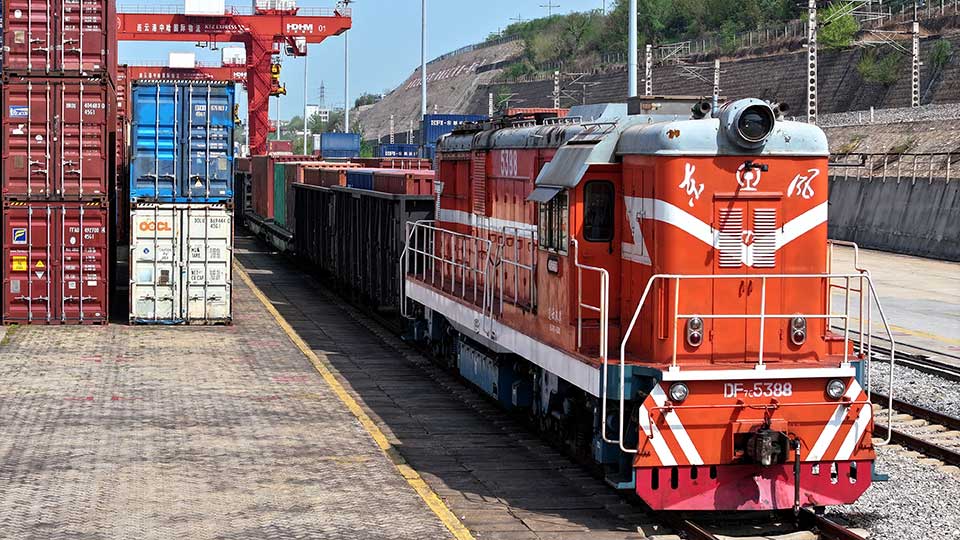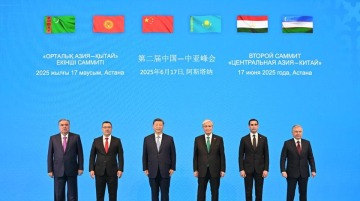
A once-overlooked trade route across the Eurasian landmass is now a key strategic priority for China in this new era of global uncertainty. The Middle Corridor—a multimodal network stretching from China’s western border through Kazakhstan, across the Caspian Sea, and into Europe via Azerbaijan, Georgia, and Türkiye—has shifted from a peripheral option to a central pillar in Beijing’s geopolitical agenda.

A perfect storm of strategic imperatives—Russia’s war in Ukraine crippling northern routes, Houthi attacks threatening vital maritime chokepoints, and Beijing’s growing determination to escape U.S. naval dominance. As China pours hundreds of millions into new ports, railways, and logistics hubs across Eurasia, the Middle Corridor is quietly reshaping the balance of power across an entire continent.
From Reluctance to Recognition: Beijing’s Strategic Pivot
Initially hesitant due to the Middle Corridor’s lower competitiveness compared to the northern route through Russia, China has, since 2022, begun investing in and supporting its development.
China’s formal entry into the Middle Corridor—via the China Railway Container Transport Corporation’s participation in the Middle Corridor Multimodal Joint Venture, established by Kazakhstan, Azerbaijan, and Georgia—signals Beijing’s growing commitment to developing the route.
Why China is Leaning Into the Middle Corridor
China’s growing engagement with the Middle Corridor is driven by three main factors:
- A drive to diversify trade routes,
- Shifting dynamics in Central Asia and South Caucasus
- Broader global geopolitical instability.
Since the early 2000s, China has sought to reduce its reliance on maritime trade routes, where U.S. influence is strongest, by developing alternative overland connections. In this context, land-based corridors have become crucial for sustaining and securing trade flows.
The Middle Corridor has emerged as a key complementary route. It not only broadens China’s access to European markets but also enhances resilience by offering alternatives in times of disruption.
The corridor includes two main transit paths: one through Georgia to the Black Sea with onward sea shipment to Europe, and another entirely overland via Georgia and Türkiye into the EU. This internal route flexibility gives Chinese companies greater agility to adapt to shifting conditions and navigate emerging risks.
Shifting Geopolitical Dynamics
Beyond China’s strategic motivations, regional developments in Central Asia and the South Caucasus have increased the credibility and appeal of the corridor. In the South Caucasus, ongoing peace negotiations between Azerbaijan and Armenia have eased tensions. Meanwhile, the historic border agreement between Kyrgyzstan and Tajikistan marks a significant step toward greater regional stability.
This relatively peaceful environment makes the Middle Corridor a more secure and predictable trade route for China—an important advantage amid growing global geopolitical uncertainty.
The Middle Corridor weakens Russia’s traditional dominance over Central Asia by reducing the region’s reliance on Russian transit routes.
Furthermore, the proactive initiatives taken by the countries along the Middle Corridor since 2022, aimed at developing and optimizing both the hard and soft infrastructure of the route, have helped lower transportation costs and reduce bureaucratic obstacles.
Compared to the period before 2022, thanks to these regional efforts, the Middle Corridor now presents China with a more stable pathway and an increasingly competitive alternative for its trade flows.
Finally, and perhaps most importantly, the Middle Corridor runs through countries eager to strengthen their political and economic ties with Beijing. These states maintain friendly and cooperative relations with Beijing and are committed to the joint development of the corridor.

This sharply contrasts with the northern route through Russia—where Moscow wields significant leverage as a key transit country—and maritime routes dominated by the United States, which could jeopardize China’s trade in the event of a confrontation.
With supportive and cooperative partners along the Middle Corridor, the route provides China with a strategically safer, more resilient, and politically favorable alternative—bolstering its efforts to diversify trade routes and strengthen long-term economic security.
The Russia Factor
First, the Russia-Ukraine war has directly impacted the northern corridor and reduced Russia’s advantage as a transit country. International sanctions imposed on Russia have affected the traditional Russia-Belarus transit route, while the ongoing conflict in Ukraine has severely damaged the country’s infrastructure, eliminating Ukraine’s role as a viable transit hub.
Additional factors such as restrictions on insurance for shipments, sanctions on the Russian banking sector, and increasing uncertainty surrounding Russia’s domestic political environment have further discouraged foreign companies from using the northern corridor for China-EU land-based trade.
Red Sea Disruptions
With approximately 60% of China-Europe trade—including high-value sectors like automotive exports—typically passing through the Suez Canal, disruptions in this corridor have had a profound impact. The cost of shipping a container to Europe surged from around $3,000 in December 2023 to $7,000 in January 2024 amid continued attacks in this critical maritime chokepoint.
These disruptions are compounded by broader political tensions. The confrontational stance taken by the Trump administration has heightened Beijing’s perception of strategic risk in maritime trade, reinforcing long-standing concerns about U.S. naval dominance and the potential weaponization of sea lanes.
Recent geopolitical shifts have underscored for China the risks of over-reliance on maritime routes, while also revealing that depending solely on a single overland corridor through Russia carries long-term vulnerabilities. In response, China has stepped up its engagement with the Middle Corridor, a strategically valuable route that runs through politically stable and unsanctioned countries.
Investing in Insurance: China’s Infrastructure Power Play
China has translated its strategic interest in the Middle Corridor into concrete action through targeted investments and partnerships designed to optimize the route. A central focus has been the development of port infrastructure—critical for resolving cargo flow bottlenecks and increasing handling capacity across the trans-Caspian corridor.
In this context, China has aligned its efforts with those of regional partners to enhance port operations on both sides of the Caspian Sea. Kazakhstan Temir Zholy, Kazakhstan’s state-owned national railway company and the Lianyungang Port Group, a major Chinese state-owned port and logistics operator based in Jiangsu Province, have agreed to jointly invest in a container hub at the Port of Aktau, located on Kazakhstan’s Caspian coast.
Similarly, China, Kazakhstan, and Azerbaijan have signed an agreement to develop a joint cargo terminal at Azerbaijan’s Port of Alat, designed to streamline the transfer of goods between ships, trains, and trucks. Both initiatives aim to reduce transit times, lower costs, and expand cargo-handling capacity, ultimately boosting the efficiency of the trans-Caspian corridor.

China’s ambitions go further. It is currently the sole bidder for the construction of Georgia’s Anaklia Deep Sea Port—a strategically significant project that would improve the corridor’s capacity to accommodate heavy and oversized cargo, meeting the growing demands of China–EU trade. Once operational, Anaklia is expected to elevate both the economic and geopolitical relevance of the Middle Corridor.
To address a persistent logistical constraint—the limited number of vessels operating in the Caspian Sea—China and Kazakhstan have also begun exploring joint shipbuilding initiatives. This effort would boost maritime capacity and ensure more reliable connectivity across the sea.
China’s involvement extends beyond bilateral agreements to multilateral platforms such as the Beijing-based Asian Infrastructure Investment Bank (AIIB), which has emerged as a key player in the development of the Middle Corridor since the Russia-Ukraine war began in 2022. It has financed critical infrastructure upgrades, including:
- The modernization of the Jezkazgan–Karagandy road corridor in Kazakhstan is a critical segment of the route.
- A $250 million investment in rehabilitating the Divriği–Kars–Georgia border railway significantly boosted rail freight capacity.
These developments demonstrate a new strategic reality:
- China is actively investing in critical infrastructure, such as ports, terminals, and rail upgrades, to address logistical bottlenecks and streamline cargo movement along the corridor.
- Beijing’s projects are increasingly aligned with the goals of corridor countries, supporting cooperative development and fostering stronger economic ties with Central Asia, the South Caucasus, and Türkiye.
- China is actively engaging with both branches of the Middle Corridor—the Georgia–Black Sea–Europe route and the overland Georgia–Türkiye–EU route.
By actively supporting both branches of the corridor is building strategic redundancy. This layered approach helps mitigate external disruptions, enhances flexibility, and strengthens the corridor’s ability to absorb geopolitical and logistical shocks.
Winners and Losers: The Geopolitical Aftershocks
China’s growing engagement with the Middle Corridor not only advances its goal of diversifying trade routes, but also creates broader strategic openings. Against the backdrop of the U.S.’s nationalist America First approach and the EU’s cautious outreach to Central Asia, China’s cooperation with Middle Corridor countries is strengthening ties with both Central Asia and the South Caucasus. This momentum is making corridor countries more receptive to Chinese partnerships and helping to attract greater Chinese investment.
At the same time, the Middle Corridor weakens Russia’s traditional dominance over Central Asia by reducing the region’s reliance on Russian transit routes. This shift also erodes Moscow’s leverage over China in overland China–EU trade, while boosting China’s strategic autonomy.
However, the geopolitical shift is not without consequences for others. If the U.S. and EU remain passive, China’s deepening presence in the corridor could limit Western influence in the region. For Washington and Brussels, this underscores the need for more proactive engagement if they hope to remain relevant players in the evolving Eurasian connectivity landscape.
Yunis Sharifli is a non-resident fellow for Central Asia at The China-Global South Project







